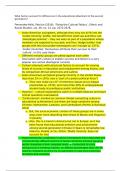What factors account for differences in the educational attainment of the second
generation?
Fernandez-Kelly, Patricia (2016), ‘Fixing the Cultural Fallacy’, Ethnic and
Racial Studies, vol. 39, no. 13, pp. 2372-2378.
- Asian-American youngsters, although they may not all fit into the
‘model minority’ profile, still benefit from what Lee and Zhou call
‘stereotype promise’ – they are seen as part of a population whose
members are expected to succeed, and thus ‘dodge bullets’ that
groups with less favourable stereotypes can’t escape (p. 2373).
- ‘model minorities’ themselves attribute their success to their
‘culture’, in this case Asian.
- Different minority groups are pitted against each other
- Fascination with culture to explain success and failure is a very
popular one across ideological currents
- Culture intersects with structural factors to account for varying
levels of success in education and employment among Asians, and
by comparison African-Americans and Latinos
- Asian Americans as fastest growing minority in the United States
(less than 2% in 1970; now a “part of a potent political force”)
o They now make up 1/5th of entering classes at Ivy league
universities (p. 2374); and more than 40% of undergraduate
student body at prestigious public institutions
- However – cultural explanations usher in multiple fallacies and leave
critical questions unanswered
- ‘Confucianism’ invoked as common thread connecting culture to
educational achievement: but there are large variations among
Chinese, Vietnamese, Laotians, and Cambodians (Portes & Rumbaut,
2014)
o But, the socio-economic contour of these groups are in some
ways even more dispiriting than those of Blacks and Hispanics
in poverty
o Also, this is a trend in America but not in Europe: as it has
been found that educational ambition and achievement
among second-generation Chinese in Spain is remarkably low
(Alarcon, Parella, & Yiu, 2014). ‘Model minority’ does not
account for that
- Hyperselectivity: conditions in which immigrants from educated and
comparatively affluent sectors in home countries achieve equal or
better standing in their adopted lands connected to class
background in sending nations, so affords advantages that can be
used by migrants as they try to assimilate in new and unfamiliar
locations and societies
, - Emphasis should be shifted from culture to class: i.e. if raw
achievement is measured only by educational advancement,
Mexicans are the most successful group in the US (graduate high
school, which is better than their parents)
- Class also explains why Cambodian and Laotian refugees hailing
from poorly educated, rural environments, have fared poorly despite
their Asian provenance, contrasting to Chinese immigrants tending
to hail from educated sectors in their own countries (pp. 2374-5) –
Colonialism? Laos and Cambodia were colonies like Vietnam – but
China, Japan and Korea were not colonised by western nations.
- Class measured by parental education and occupation also explains
the educational success of recent immigrants from Nigeria and
Ghana (Hamilton, 2014) – representation in Ivy League universities
is comparable to Asian American rates. (p. 2375)
- Social class entails differences in collective capacity to command
physical and symbolic resources: good education lucrative
employment and are ways in which a prominent class standing is
expressed.
- “class breeds culture” – instruction does not vary substantially
across intl borders, capturing conventions and ideas transmitted
across generations among those in dominant positions
- Bourdieu (1977): ‘habitus’: semi-automatic responses that can
increase individual efficacy: culture not a fixed category but a
‘toolkit’ from which individuals take implements to navigate social
waters – fluid process iterating with social class as people seek to
adapt in surrounding environments.
- Even poorly educated ‘boat people’ (refugees) from Vietnam derived
benefits from positive public perceptions about Asian Americans
- Public perception started in the 1960s: immigrants from China,
Vietnam and Taiwan used resources from home to settle and prosper
in America, giving rise to the stereotype of the ‘model minority’
- ‘stereotype promise’ (coined by Lee, 2013): designate public and
simplified perceptions that convey distinct benefits to members of
specific ethno-racial groups – Steele & Aronson (1995):
demonstrated how internalised notions about one’s group influence
social performance
o Negative portrayal of a group in public domain tends to
influence their ability to do well in standardised tests, realising
the ‘stereotype threat’
o Diminish self-concept of students and job applicants; but
positive perceptions can push them in the opposite direction,
enhancing performance. (pp. 2375-6)




